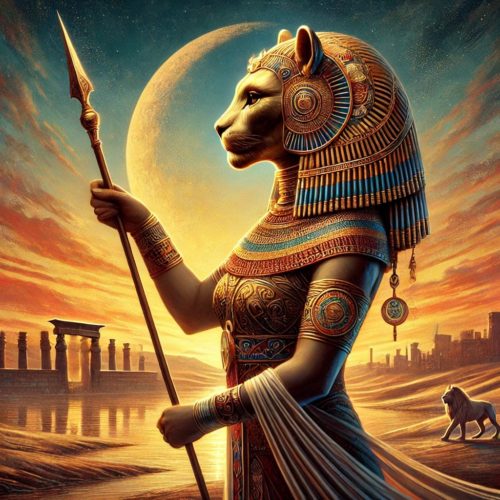Menhit is an ancient Egyptian goddess associated with war, hunting, and protection. She is often depicted as a woman with the head of a lioness, symbolizing her fierce and untamed power. Her name, “She Who Slaughters,” reflects her role as a guardian and warrior goddess, embodying strength and determination. The lioness, a natural hunter, perfectly represents her dominion over the battlefield and the hunt. In artistic depictions, Menhit is sometimes shown armed with a spear, ready to defend her people and smite enemies.
Roles and Attributes
Menhit was revered as the protector of the pharaohs and the Egyptian army during times of war. Her presence was invoked to bring courage and victory on the battlefield. She was believed to watch over soldiers as a guardian, ensuring their safety and triumph in battle.
Beyond her martial role, Menhit was also associated with hunting, reflecting her lioness attributes. Her influence extended to fertility, as she was believed to rejuvenate the land and provide for her people. Farmers sought her blessings for bountiful harvests, and her protective nature was invoked to safeguard the community from harm.

Cult and Worship
Menhit’s primary cult center was located in the city of Esna, where she was worshiped as a local goddess of war and hunting. Temples dedicated to her often featured depictions of her in her lioness form, emphasizing her connection to both strength and protection. Statues and amulets of Menhit were widely used, particularly by those seeking her protection in the afterlife.
Distinctions from Sekhmet
Menhit shares similarities with Sekhmet, another lioness-headed goddess of war, but there are important distinctions between the two. While Sekhmet embodies vengeance, destruction, and plague, Menhit is more associated with protection, hunting, and fertility. Sekhmet’s role often focuses on her wrathful nature, whereas Menhit’s is tied to safeguarding the pharaoh and ensuring harmony through her strength.
Legacy and Influence
Though not as widely known as some other Egyptian deities, Menhit holds a significant place in the Egyptian pantheon as a symbol of balance between war and protection. Her lioness form and attributes have made her a timeless emblem of courage, strength, and guardianship.
Statues, reliefs, and inscriptions of Menhit continue to intrigue modern audiences, shedding light on her essential role in the lives of the ancient Egyptians. Her influence, particularly as a goddess who protected the pharaoh and ensured safe journeys in the afterlife, remains a key element of her enduring legacy.
